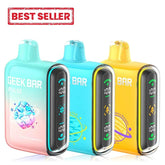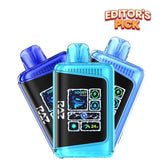Temperature Control (TC) Mode on Vapes: The Ultimate Guide
Temperature control mode is crucial in vaping, ensuring longer battery life, preventing dry hits, and extending coil and wick lifespan. The device automatically monitors coil temperature, allowing users to adjust it to their desired setting, enhancing the vaping experience. This post explains the temperature control operation on vapes, provides information for optimal use, and discusses its advantages and disadvantages.

What is Temperature Control on Vapes?
The technological remedy for dry and burned hits in vape mods is temperature control (TC). Because the temperature doesn't rise or fall, it produces steady vapor while allowing for longer drags. The user typically selects the temperature limit and falls within the ranges of 300°F and 600°F (100°C and 315°C). After that, an automatic adjustment of the power supplied to the coil maintains the coil's temperature and that of your vaporizer.

How Does the Temperature Control (TC) Mode Work on Vapes?
Many vapers are unaware of how their vaporizer's TC feature functions. As a result, we've put up an in-depth overview of its operation.
The temperature control method of a vaporizer uses resistance, a fundamental electrical property principle. The TC feature limits the current that passes through the coil in your vape when you take a puff. The temperature at which the e-juice will vaporize depends on this flowing current.
The most common vaping wire, kanthal, already has a static resistance value. However, this depends on the sort of vaping equipment you use. On the other hand, others can grow due to greater temperatures, which is how the TC function was created.
When using coils with variable resistance, the resistance increases as the coil's temperature rises. This makes keeping the temperature steady for vaping's smooth hits easier.
The 2014 DNA chip development by the business EVOLV is responsible for the breakthrough temperature control concept in vaporizers. According to various consumers, mods containing these DNA chips have been the finest alternative for vapes since 2014.
Before the introduction of TC mods, the first high-quality mods made by EVOLV could only be adjusted for changing voltage or wattage, which was a benefit for innovation to vapes. Today, most high-quality vapes come equipped with a temperature control feature.

Benefits of Temperature Control Feature?
- When you vape, TC prevents dry and burnt hits, killing their risk before it starts. This is great for vapers of all skill levels because you may have the same consistently enjoyable experience and avoid the feeling that your vaping worsens with each inhale.
- Your coils will last longer at an ideal temperature.
- As a result, the coil only heats up to the appropriate level needed, extending the battery life.
- Greater control over factors like flavor and selecting the ideal heat complementing a quick inhale or a slow, deliberate one for more vapor.
- Guards your e-cigarette's tank and other parts.
Drawback on Temperature Control on Vapes?
- One restriction on your options is that it only works with certain coil types, like stainless steel, nickel, and titanium. For instance, Kanthal, a common choice for most vapes that only operate at variable wattages, is incompatible with TC mode.
- It can be difficult for inexperienced vapers because temperature control needs modifications to obtain the ideal temperature.
- A few devices have this option but have trouble balancing temperature control and wattage to deliver a satisfying vape.

What Do I Need to Use the TC Feature?
It takes two items to vape in TC mode. The first item is a vape mod that offers temperature control vaping. As previously stated, temperature control is a firmware feature. Manufacturers may easily add the capability to the forthcoming series of vape mods since the work required to program TC mode is complete. There's a good chance the box mod you own supports TC mode if it was made in the last five years.
The second item you want is a rebuildable atomizer or vape tank with a coil manufactured of a material with a suitable high TCR. If a coil has a low TCR, it is unsuitable for TC vaping since the resistance changes as the coil heats up is so minute that measuring it would require susceptible equipment.
How to Vape in Temperature Control?
Switch to TC mode and choose the correct wire type for your coils. Ensure the tank and mod are at room temperature before starting.
Install the coil tightly, tighten the screw, and tighten the tank or atomizer. If necessary, lock the resistance and confirm it with the +/- buttons. Stainless steel coils can be dry-burned with a rebuildable atomizer, but start low power and avoid dry burning. Space coils slightly to avoid hot spots, and the mod will recognize resistance more consistently.
FAQ?
Best Temperature to Vape Liquids?
Common vaping temperatures range between 390°F and 480°F (200°C and 250°C). Determine the temperature you want. Ideally, you'll experience a satisfying vape. Since it's TC, you shouldn't have to worry about scorching the coil or wick while inhaling for extended periods. However, you'll notice a considerable vapor decrease when your battery runs out. Otherwise, everything should be as usual. If required, raise or lower the temperature.
What if the Temperature is too High?
Using excess medium at a too-high temperature in vapes can produce a burnt taste.
What if the Temperature is too Low?
Too little vaping heat might lead to weak hits with little flavor or body.
Material Types for Temperature Control Coils
The following are some common parts used to create TC vaping coils:
- Stainless Steel
- Nickel 200
- Titanium Grade 1
- Nickel Ferrous

Difference Between Temperature Control vs Variable Wattage?
There are conflicting opinions in the vaping world about temperature control, even though it is still a setting used in various high-powered mods to maximize your vape. Temperature control is a great invention that allows users greater control over their vaping when it functions properly.
However, not all TC modes on vapes perform effectively. For experienced vapers aiming to boost taste and cloud production, using TC mode properly can be a game-changer.
But generally speaking, variable wattage is a better option because temperature management is a tricky topic that calls for in-depth knowledge. It doesn't require as much expertise, and you'll find that most devices' wattage settings are simple to modify.
The vaper receives more power and greater efficiency without the hassle of learning about various coils. Since it is simpler, safer, and more widely available, variable wattage is preferable to temperature control.














